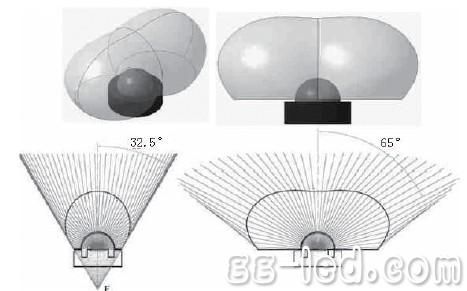[Source: "High-tech LED-technology and application" October issue Zhao Feng dance]
First, the background The development of LED (Light Emitting Diode) technology has opened up a new era of lighting technology revolution. LED lighting technology has been rapidly developed in recent years due to its small size, long life, high electro-optical efficiency, environmental protection and energy saving. At present, a single LED light source on the market can actually achieve 130 lumens per watt. The
Street Lamp with a traditional 250 watt sodium lamp as the light source can be used to replace the LED light source, and only about 60 1W LEDs can produce the same brightness. Greatly saves energy consumption. Since the radiation angle distribution of most LED light sources is Lambertian distribution of 110 degrees to 120 degrees, if there is no light distribution design, the light pattern on the ground will be a large circular spot. 50% of the light scattered outside the road is not used, and it will glare into distant vehicles or pedestrians, which is inconsistent with the requirements of road lighting. The Urban Road Lighting Design Standard requires that the light distribution of street lamps be a rectangular spot, and almost all of the light is distributed on the road surface. For the main road, a light-cut or half-cut light distribution design is also needed, which can improve the utilization efficiency of light on the one hand and avoid glare on the other hand.
Conventional LED street lamps use secondary optical lenses for light distribution, so at least two faces are added in the middle (that is, the Fresnel loss of the two faces is increased), and the size of the secondary lens is relatively large, plus The absorption of light by the lens material itself will greatly affect the light extraction efficiency of the entire system.
Second, the light distribution design We use the idea of integrating secondary optics and primary optics, directly packaged with the chip (that is, directly on the optical lens for light distribution), and many links will be omitted in the middle to minimize the loss of optical energy. The surface calculation of a single optical lens combines the edge optics principle and the node normal vector matching method of the surface control mesh. The primary lens we discuss below has the same light distribution angle as the secondary lens. °, Y direction 65 ° (where the X direction is along the road direction, the Y direction is perpendicular to the road direction), the lens material is PC, the light distribution curve and uniformity are designed according to the national road lighting design standards. The design principle of the primary lens is shown in Figure 1.

The beam angle perpendicular to the road direction is also ±32.5° (left cross-section), and the beam angle along the road direction is ±64° (right cross-sectional view). In the direction perpendicular to the road, the outgoing beam is concentrated, the angle between the edge rays and the optical axis is 32.5°, and the reverse extension of all outgoing rays intersects the virtual focus F; and along the direction of the road, the outgoing beam It is divergent, and its angle between the edge light and the optical axis is also 65°. The bottom of the lens has a concave spherical surface for filling the silicone to directly package the lens and the LED chip. The silica gel selects the material with the refractive index closest to the primary lens, so that the light emitted by the chip passes through the silica gel and enters the lens to maintain its propagation direction. constant.
Third, the light distribution calculation Since general optical software (such as Zemax, CodeV, etc.) is not mature enough for the optimization design of free-form surfaces, designing an asymmetric free-form surface requires a lot of time to manually adjust and set the operating parameters repeatedly, a more complicated freedom. Surfaces often take up to a month or even months, and sometimes the optimized surfaces are less efficient than optical. Here, the principle of conservation of edge ray etendue (Etendue) is used to create an accurate calculation method for the node vector of a free-form surface control grid, which can be optimized in a short time (generally several hours or even shorter). Free-form optics with excellent efficiency and precise light distribution.
Unfinished
For more information, please refer to the October issue of "High-tech LED-Technology and Applications" 

![]() March 22, 2022
March 22, 2022


